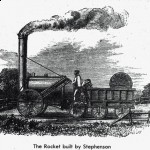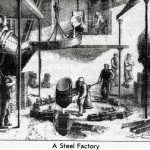The Railway Age
Category: 19th century The 18th century was a boom time for building roads. At the beginning of the century it took over three days to make the journey from London to Exeter or Manchester. By the end of the century the same journey took about 24 hours by coach. That became possible thanks to the network of new roads built by privately owned Turnpike Trusts. Until the beginning of the 19th century, however, British roads were still poor. They were badly rutted and became practically impassable in wet weather. Around the turn of the century engineers Thomas Telford and John McAdam devised methods of building uniform, smooth, and durable roadbeds on which heavy goods could be carried in carts and wagons without destroying the roads.
The 18th century was a boom time for building roads. At the beginning of the century it took over three days to make the journey from London to Exeter or Manchester. By the end of the century the same journey took about 24 hours by coach. That became possible thanks to the network of new roads built by privately owned Turnpike Trusts. Until the beginning of the 19th century, however, British roads were still poor. They were badly rutted and became practically impassable in wet weather. Around the turn of the century engineers Thomas Telford and John McAdam devised methods of building uniform, smooth, and durable roadbeds on which heavy goods could be carried in carts and wagons without destroying the roads.
Water transport was rather slow, greater speeds were demanded. The idea of railway emerged as a result of the development of steam locomotivess, but building locomotives and rail systems was so expensive that railroads were not widely used in Britain until the 1830′s.
The first practical locomotive was constructed in England in 1804 by Richard Trevithick. It had smooth wheels operating on smooth metal rails. At first the railway was looked on mainly as a means of carrying goods, but it was soon discovered that the steam engine was capable of far higher speeds than had been imagined and that it could carry passengers more quickly and more cheaply than the stage coach.
After the successful trials of the Trevithick locomotive, a number of moderately successful locomotives were built in England, primarily for use in mining. In 1823 the Stockton-Darlington Railway was opened. In 1829 the much more important line connecting Manchester and Liverpool came into existence. It was not until 1829 that a locomotive was developed for use in a railway carrying both passengers and cargo. In that year The Rocket, a locomotive designed by the British engineer George Stephenson, won a competition sponsored by the Liverpool and Manchester Railroad.
The Rocket pulled a load of three times its own weight at a speed of 20 km/hr and hauled a coach filled with passengers at 39 km/hr. This performance stimulated the building of other locomotives and the extension of railroad lines. Investors saw railroads as a profit-making venture and poured vast amounts of capital into building rail systems throughout the nation.
A regular fever of railway building, accompanied by a speculation boom and much gambling in stocks and land values, set in. In the years 1834-1836 about £10,000,000 was raised for railway construction. First in the industrial areas, then on the main routes radiating from London and then on the minor branches, thousands of miles of track were laid down.
Much of the capital expended on these works brought in no immediate profit, and in 1845 there was a severe crisis extending to many branches of industry and affecting a number of the banks. This crisis soon passed, being rather the result of speculative optimism than of any real instability of the railway companies, and was followed by the new outburst of building.
The railway building marked the beginning of a tremendous increase in all branches of heavy industry, especially in such key industries as coal mining and iron. The output of pig iron was 678,000 tons in 1830; in 1852 it was 2,701,000 tons. Coal output rose from 10,000,000 tons in 1800 to 100,000,000 tons in 1865.
Britain was the first country to create a railway system. It also started to build railways in countries all over the world, which proved to be a very profitable business. Railroads played an especially important role in the colonial and semi-colonial countries that had not a sufficiently dense population or money enough to build for themselves. Such railroads were usually not only built by British contractors but financed by loans raised in London.
The immediate internal effect of the railway boom was to create a large demand for labour, both directly for railway construction and indirectly in the coal mining, iron and steel and other industries. In the second place, the railways made it much easier for workers to get from place to place, to leave the villages and find a factory town where work was to be had.
In 1801, 20 per cent of Britain’s people lived in towns. By the end of the 19th century, it was 75 per cent. London especially was like a great octopus with its tentacles reaching out into the surrounding country. Life in the slums of big cities was grim. Although the population as a whole was going up, more children died in the cities than anywhere else. But rail travel made it easier for the better-off to get to work. So suburbs grew up on the edge of towns, with better and bigger houses, trees and gardens.


